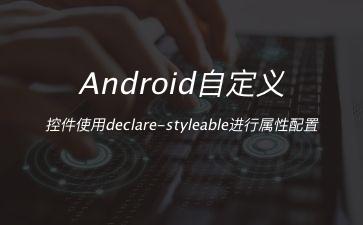1、在res/vlaues文件夹下创建资源文件attrs.xml
<?xml version="1.0" encoding="utf-8"?>
<resources>
<declare-styleable name="poster">
<attr name="icon" format="reference" />
<attr name="iconW" format="dimension" />
<attr name="iconH" format="dimension" />
<attr name="text" format="reference|string" />
<attr name="textColor" format="color" />
<attr name="textSize" format="dimension" />
<attr name="background" format="reference" />
</declare-styleable>
<declare-styleable name="settingItem">
<attr name="name" format="reference|string" />
<attr name="value" format="reference|string" />
</declare-styleable>
</resources>
a. reference:参考某一资源ID,以此类推
(1)属性定义:
<declare-styleable name = "名称">
<attr name = "background" format = "reference" />
</declare-styleable>(2)属性使用:
<ImageView
android:layout_width = "42dip"
android:layout_height = "42dip"
android:background = "@drawable/图片ID"
/>b. color:颜色值
<declare-styleable name = "名称">
<attr name = "textColor" format = "color" />
</declare-styleable>c. boolean:布尔值
<declare-styleable name = "名称">
<attr name = "focusable" format = "boolean" />
</declare-styleable>d. dimension:尺寸值(注意:这里如果是dp那就会做像素转换)
<declare-styleable name = "名称">
<attr name = "layout_width" format = "dimension" />
</declare-styleable>e. float:浮点值
f. integer:整型值
g. string:字符串
h. fraction:百分数
i. enum:枚举值
j. flag:是自己定义的,类似于 android:gravity=”top”,就是里面对应了自己的属性值
k. reference|color:颜色的资源文件
l.reference|boolean:布尔值的资源文件
注意://由于reference是从资源文件中获取,所以在XML文件中写这个属性的时候必须使用personattr:name=”@string/app_name”这种格式,否则会出错。
2.设置好属性文件后,在使用的布局中写相关配置
xmlns:myapp="http://schemas.android.com/apk/res/com.starview.tv"<com.starview.tv.view.PosterView
android:id="@+id/myview1"
android:layout_width="290dp"
android:layout_height="@dimen/settingpage_big_height"
android:background="@drawable/hello_selection"
myapp:background="@drawable/mainmenu_colorboard_blue"
myapp:icon="@drawable/icons_01catbox_dtv"
myapp:iconH="110dp"
myapp:iconW="110dp"
myapp:text="@string/str_dtv"
myapp:textColor="@color/white"
myapp:textSize="@dimen/indexsecondpagefontsize" />
3.最后在自定义控件的构造方法中获取你配置的属性值
package com.starview.tv.view;
import com.starview.tv.R;
import android.content.Context;
import android.content.res.TypedArray;
import android.graphics.Color;
import android.graphics.drawable.Drawable;
import android.util.AttributeSet;
import android.view.LayoutInflater;
import android.view.View;
import android.view.ViewGroup;
import android.widget.FrameLayout;
import android.widget.ImageView;
import android.widget.TextView;
public class PosterView extends FrameLayout
{
private ImageView mPosterIconImageV;
private TextView mPosterTextV;
private View mPosterBackground;
public PosterView(Context context)
{
this(context, null);
}
public PosterView(Context context, AttributeSet attrs)
{
this(context, attrs, 0);
}
public PosterView(Context context, AttributeSet attrs, int defStyle)
{
super(context, attrs, defStyle);
initView();
TypedArray a = context.obtainStyledAttributes(attrs, R.styleable.poster);
if (mPosterTextV != null)
{
String text = a.getString(R.styleable.poster_text);
if (text != null)
mPosterTextV.setText(text);
int color = a.getColor(R.styleable.poster_textColor, Color.WHITE);
mPosterTextV.setTextColor(color);
float size = a.getDimensionPixelOffset(R.styleable.poster_textSize, 24);
mPosterTextV.setTextSize(size);
}
if (mPosterIconImageV != null)
{
Drawable d = a.getDrawable(R.styleable.poster_icon);
if(d != null)
mPosterIconImageV.setImageDrawable(d);
int width = a.getDimensionPixelOffset(R.styleable.poster_iconW, 100);
int height = a.getDimensionPixelOffset(R.styleable.poster_iconH, 100);
ViewGroup.LayoutParams lp = mPosterIconImageV.getLayoutParams();
lp.width = width;
lp.height = height;
mPosterIconImageV.setLayoutParams(lp);
}
if(mPosterBackground != null)
{
Drawable d = a.getDrawable(R.styleable.poster_background);
if(d != null)
mPosterBackground.setBackgroundDrawable(d);
}
a.recycle();
}
private void initView()
{
LayoutInflater.from(getContext()).inflate(R.layout.poster_view_layout, this, true);
mPosterBackground = findViewById(R.id.poster);
mPosterIconImageV = (ImageView) findViewById(R.id.imageView1);
mPosterTextV = (TextView) findViewById(R.id.textView1);
}
public void setImageDrawable(Drawable d)
{
if(mPosterIconImageV != null)
{
mPosterIconImageV.setImageDrawable(d);
}
}
public void setImageDrawable(int resId)
{
if(mPosterIconImageV != null)
{
mPosterIconImageV.setImageResource(resId);
}
}
public void setText(CharSequence text)
{
if(mPosterTextV != null)
{
mPosterTextV.setText(text);
}
}
public void setText(int resId)
{
if(mPosterTextV != null)
{
mPosterTextV.setText(resId);
}
}
public ImageView getIconImageView()
{
return mPosterIconImageV;
}
public TextView getTextView()
{
return mPosterTextV;
}
public void setTextVisibility(int visibility)
{
if(mPosterTextV != null)
{
mPosterTextV.setVisibility(visibility);
}
}
public void setIconVisibility(int visibility)
{
if(mPosterIconImageV != null)
{
mPosterIconImageV.setVisibility(visibility);
}
}
public void setPosterBackground(Drawable d)
{
if(mPosterBackground != null)
{
mPosterBackground.setBackgroundDrawable(d);
}
}
public void setPosterBackground(int resId)
{
if(mPosterBackground != null)
{
mPosterBackground.setBackgroundResource(resId);
}
}
}今天的文章Android自定义控件使用declare-styleable进行属性配置分享到此就结束了,感谢您的阅读,如果确实帮到您,您可以动动手指转发给其他人。
版权声明:本文内容由互联网用户自发贡献,该文观点仅代表作者本人。本站仅提供信息存储空间服务,不拥有所有权,不承担相关法律责任。如发现本站有涉嫌侵权/违法违规的内容, 请发送邮件至 举报,一经查实,本站将立刻删除。
如需转载请保留出处:https://bianchenghao.cn/31763.html

